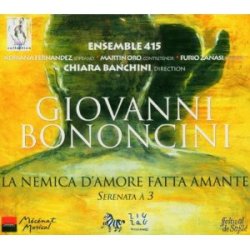Giovanni Bononcini - La Nemica D'Amore Fatta Amante - Serenata a 3 (2004)
Giovanni Bononcini - La Nemica D'Amore Fatta Amante - Serenata a 3 (2004)

01. La Nemica D'Amore Fatta Amante 02. Sinfonia: Adagio - Allegro - Adagio E Piano 03. Rezitativ: Io Che D'Amore Nemica 04. Arie: Tormentata L'Alma Mia 05. Rezitativ: Clori Perche Si Mesta play 06. Arie: Prigionirea Di Finiti Legami 07. Rezitativ: Stimi Sognato Il Laccio 08. Arie: Disprezzami Cosi 09. Rezitativ: Non Puo Sprezzarti Un Che T'Adora 10. Arie - Duett: Per Te Peno... Per Te Moro 11. Rezitativ: Clori Barbara Clori 12. Arie: Alma Infida 13. Rezitativ: Hor Che Dentro Al Mio Petto 14. Arie: Solo Efelice 15. Rezitativ: L'Arco Del Nume Infante 16. Arie: Tacero Pupille Amate 17. Rezitativ: Era Tuo Vanto Un Giorno 18. Arie: Io Geloso? Crudele Tu Menti 19. Rezitativ: Ma Senti 20. Arie: Se Di Te Venivo Amante 21. Rezitativ: Dunque A Tua Voglia 22. Arie - Duett: Basta Il Tuo Fallo 23. Rezitativ: Non M'Ami, E Il Labro Tuo 24. Arie: Dal Bell'Idolo 25. Rezitativ: Vanne Fileno, E Impara play 26. Arie: Per Far Scempio D'Un Core 27. Rezitativ: Se Estinto Vuoi Mi Rarmi 28. Arie: Quanto Sangue Ho Nel Mio Petto 29. Rezitativ: Or Che Non V'E Chi Osservi 30. Arie: Purti Riveggio Ancor 31. Rezitativ: Tirsi Vedesti Mai 32. Arie: Tortorella Innamorata 33. Rezitativ: Mio Tesero E Clori Mio Bene 34. Arie: Se Un Gran Piacere Puo Far Morire 35. Rezitativ: Morir Paventi? 36. Arie: Chi D'Amore Disprezza Il Dardo Clori - Adriana Fernandez - soprano Tirsi - Martin Oro - contratenor Fileno - Furio Zanasi - barítone Orchestra: Ensemble 415 Chiara Banchini – conductor
Giovanni Bononcini(Modena 1670-Vienna 1747) is best known today for his dozen years in London, which began when he was 50 and Handel was 35. Five years later a well-known epigram likened them to Tweedle-dum and Tweedle-dee. Bononcini established his fame in the 1690's by composing more than 200 solo cantatas; six serenatas, each of which had 3 or 4 characters and in addition wrote five complete operas.
In 1692 Bonancini was employed by the Colonna family in Rome, which proved to be a turning point in his life, for there he met Silvio Stampiglia,who became his librettist. This resulted in 6 Serenatas, one of which is on this disc.. Together they also wrote 5 operas and an oratorio. These works made Bonancini's name as a composer and man of the theatre.
This music is in the form of a Serenata for three voices. The Serenata was a new type of cantata developed by Bononcini and A. Scarlatti. The 3 voices are: Soprano (Clori}sung by Adriana Fernandez,countertenor{Tirsi)sung by Martin Oro and Baritone (Fileno) sung by Furio Zanasi. The story is basically a love triangle with both men loving Clori. It's absolutely charming and delightful in every way.
Clori, who is 'The Enemy of Love' refuses to relinquish her highly prized liberty. The complete score of this work does not survive, but one copy of the libretto is extant. There is however, a dedication for this work, written by Bononicini in which he requests a favorable reception for the 'poor sheperdess' (Clori). Such pastoral contexts were highly favored, since they embodied the ideals of the Arcadian Academy founded in Rome in 1690.
The essence of Stampiglia's drama, brought forth by Bononcini'c music, is marvelously conveyed by the Ensemble 415's rendition (13 players) . The use of the Archlute at the opening playing dreamily for a brief time creates the perfect effect for the entering of the Ensemble and the first complete chord. There is no doubt that Clori (sop.Adrian Fernandez) is the fascinating focus of this work (7 arias,2 duets), while Tirsi (Martin Oro, Countertenor), whom she loves, has only 3 arias and l duet; and Fileno (Furio Zanasi-baritone), whom she repels, has 3 arias and 1 duet.
Adriana and her Buenos Aires compatriot, Martin Oro, add ornamentation judiciously with a magical, if at times a bit rapidly, floating quality. Oro's arias are all moderately slow effectively conveying the dramatic function of each one. Zanasi sings his rapidly paced arias powerfully, each one filled with high drama, entering furiously with periodical jealous outbursts until he angrily departs with an invective-filled aria. Thus he and Oro are at opposite ends of the pole and vocal production.
The singers do justice to the drama , and the singing is par excellence. There is an especially rich orchestral accompaniment with good balance between the singers and the orchestra. Bononcini took special pains to bring out the solo instruments, as in the arias of Clori, which is accompanied by a solo violin and Tirsi which features a solo on the cello. It's all incredibly beautiful and the voice of Martin Oro is divine!
In 2003, when this serenata was 310 years old, it was given this 'most sumptuous' recording by Ensemble 415. It truly belongs to the collections of all who enjoy renditions of melodically, harmonically and texturally rich works composed near the end of the splendid 17th century. The album is beautifully packaged and includes pertinent information as well as the text in Italian, French, English and German. --- George Peabody "Ariel" (U.S.A.)
download: uploaded anonfiles mega 4shared mixturecloud yandex
Last Updated (Wednesday, 11 September 2013 14:13)
